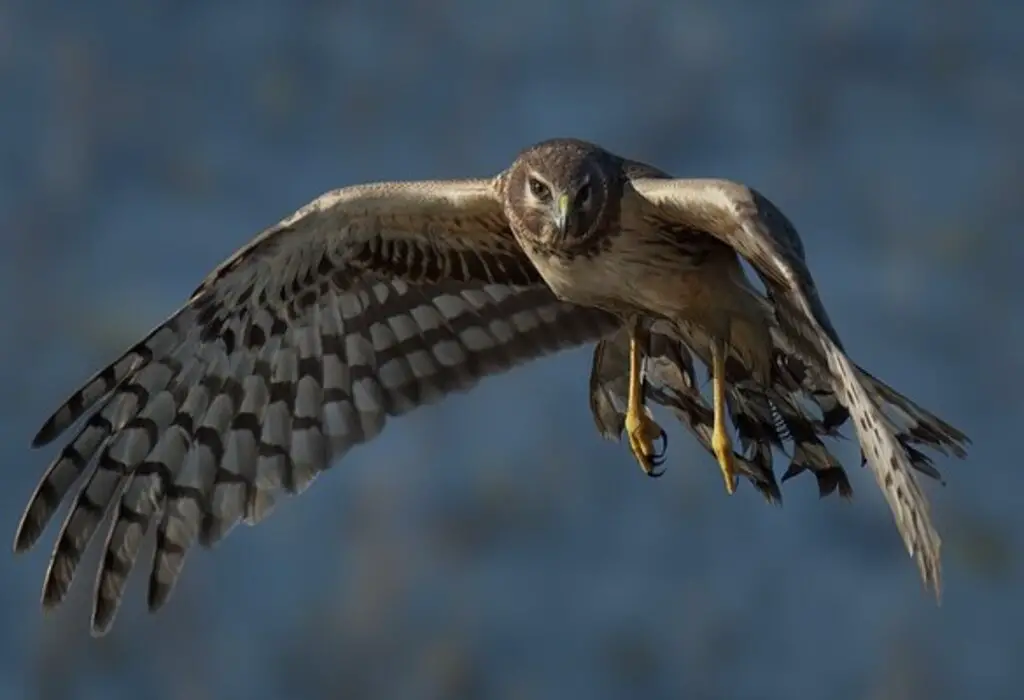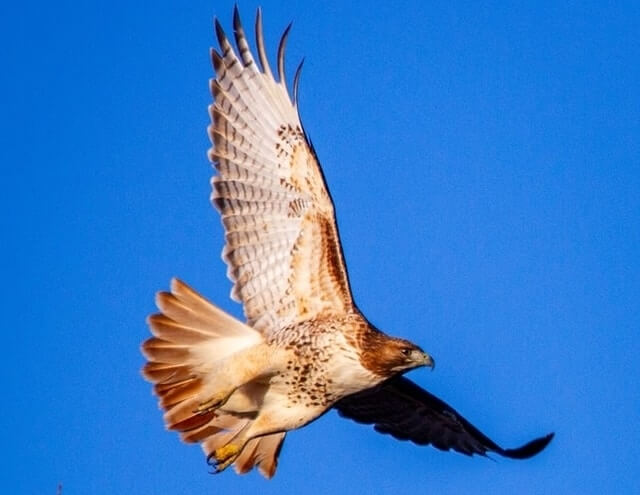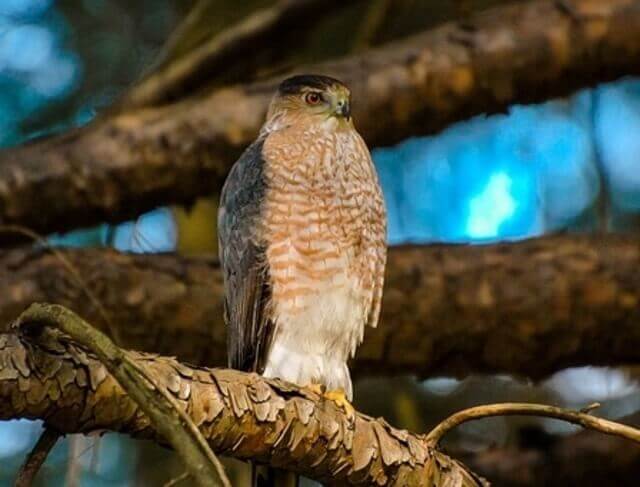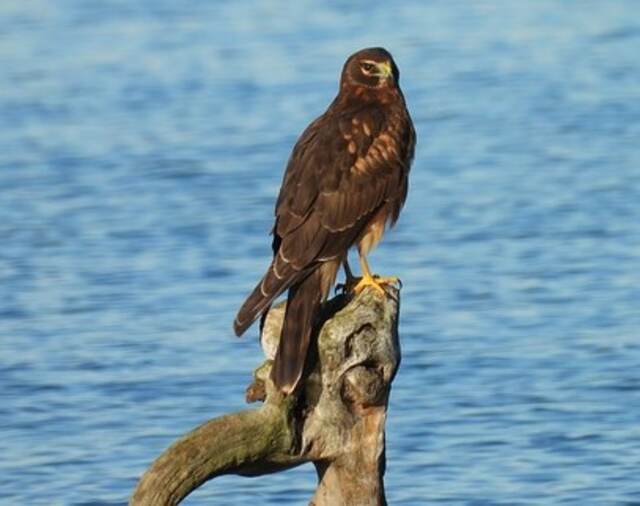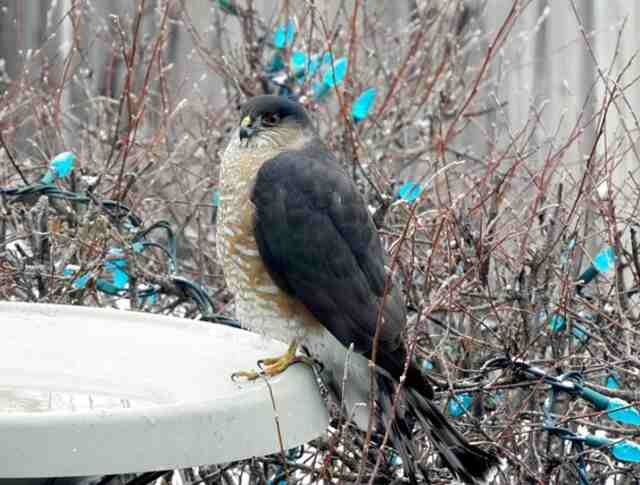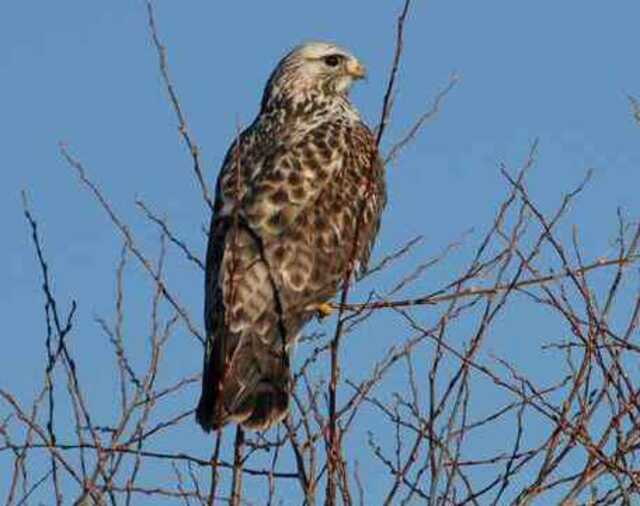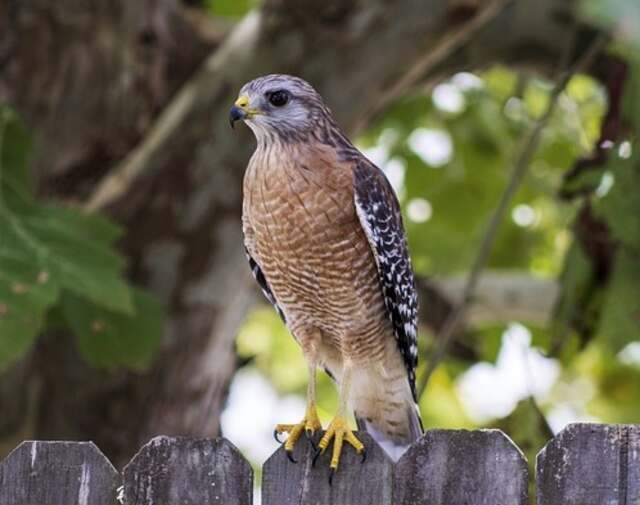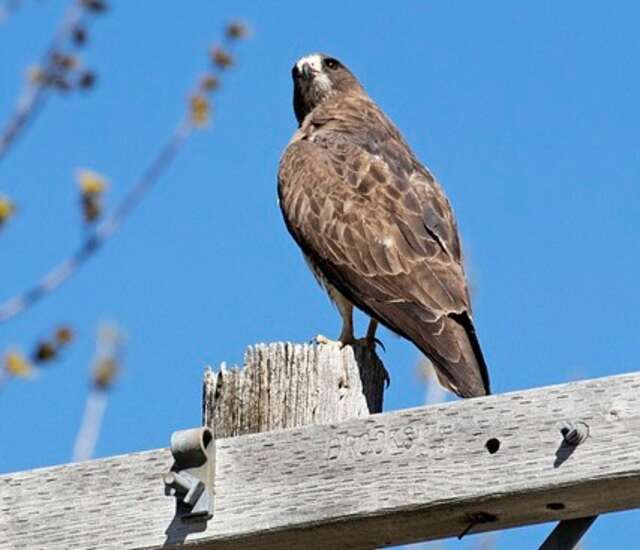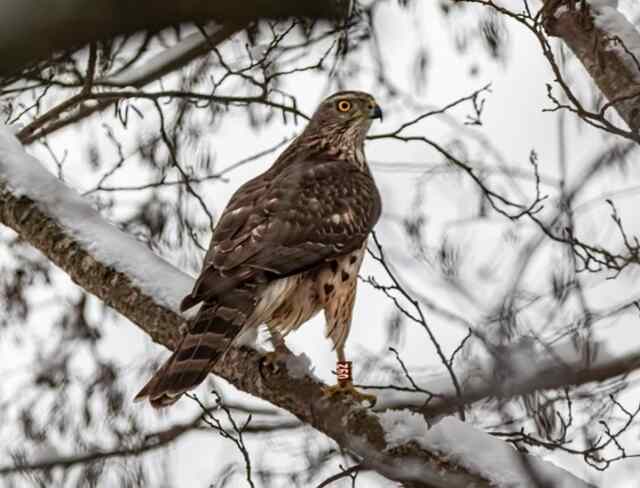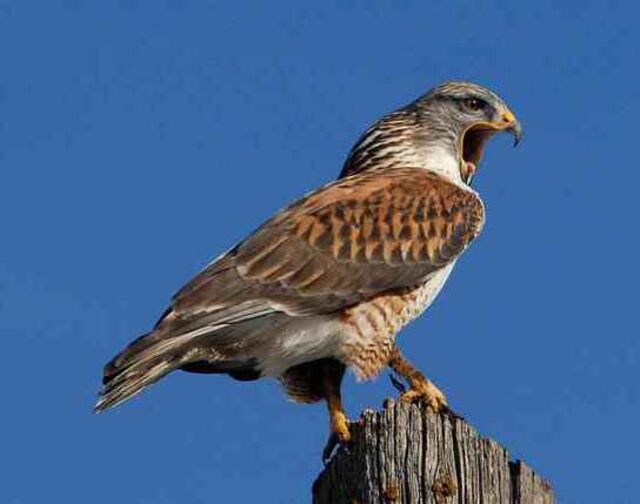Dive into the world of hawks in Iowa with our ultimate guide featuring 10 distinct types! From the majestic Red-tailed Hawk to the agile Cooper’s Hawk, Iowa’s skies are home to a diverse array of these impressive raptors.
In this comprehensive guide, we’ll explore the unique characteristics, habitats, and behaviors of each hawk species, providing valuable insights for bird enthusiasts and nature lovers.
Table of Contents
Types of Hawks in Iowa
Red-tailed Hawk
- Length: 17.7-22.1 in (45-56 cm)
- Weight: 24.3-45.9 oz (690-1300 g)
- Wingspan: 44.9-52.4 in (114-133 cm)
- Scientific Name: Buteo jamaicensis
- Frequency of Occurrence: 16.52%(Statistic: eBird)
- Maps: Range Map – Sightings Map
- Sounds: Calls
Red-tailed Hawks have an incredibly wide distribution range, occupying just about every type of open habitat on the continent including deserts, scrublands, grasslands, roadsides, fields and pastures, parks, broken woodland, and (in Mexico) tropical rainforest. They mainly feed on mammals such as voles, mice, wood rats, rabbits, snowshoe hares, jackrabbits, and ground squirrels, as well as birds, snakes and carrion.
Red-tailed Hawks typically put their nests in the crowns of tall trees where they have a commanding view of the landscape, or they may also nest on cliff faces, artificial ledges, or billboard platforms. Both members of the pair build the nest, or simply refurbish one of the nests they’ve used in previous years.
The nest is typically a tall pile of dry sticks up to 6.5 feet high and 3 feet across, lined with bark strips, fresh foliage, and dry vegetation. Construction of the nest typically takes 4-7 days.
Read more about this bird: Interesting Red-Tailed Hawk Facts That Will Amaze You!
Cooper’s Hawk
- Length:14.6-15.3 in (37-39 cm)
- Weight: 7.8-14.5 oz (220-410 g)
- Wingspan: 24.4-35.4 in (62-90 cm)
- Scientific Name: Accipiter cooperii
- Frequency of Occurrence: 3.79%
- Maps: Range Map – Sightings Map
- Sounds: Calls
The Cooper’s Hawk (Accipiter cooperii) is a medium-sized hawk native to North America, with a distribution range extending from southern Canada to northern Mexico. It can be found in a variety of habitats, including mature forests, open woodlands, wood edges, river groves, tree lines, small woodlots, riparian corridors, parkland, scrub areas, and even in some suburban and urban settings.
While it prefers to nest in tall trees with ample cover, it will also nest in shrubs and even on the ground when necessary. Its diet consists mainly of birds and small mammals, which it hunts using stealth tactics. It will approach its prey through dense cover and then pounce with a rapid, powerful flight. In addition to its bird and mammal prey, Cooper’s Hawks also sometimes eat reptiles, insects, and even fruit.
Reproduction typically involves courtship flights and the male bringing food to the female prior to egg-laying. The female then incubates the eggs and feeds the young when they hatch. Young Cooper’s Hawks are able to climb about in their nest tree after about 4 weeks and can fly at about 4-5 weeks of age.
Read more about this bird: 20 Cooper’s Hawk Fun Facts (with Photos & Information)
Northern Harrier
- Length:18.1-19.7 in (46-50 cm)
- Weight: 10.6-26.5 oz (300-750 g)
- Wingspan: 40.2-46.5 in (102-118 cm)
- Scientific Name: Circus cyaneus
- Frequency of Occurrence: 2.68%
- Maps: Range Map – Sightings Map
- Sounds: Calls
The Northern Harrier is a large hawk found across North America, from Canada to Central America. It prefers open habitats such as grasslands, marshes, prairies, old pastures, and cultivated areas. It also nests and hunts in shrubby wetlands near agricultural areas. Its diet consists mostly of small mammals and birds, although its diet varies with location and season.
Northern Harriers usually nest on the ground either alone or in loose colonies, and one male may have two or more mates. During breeding season, they eat small mammals, reptiles, amphibians, and birds, while during winter they feed almost exclusively on meadow voles.
Unfortunately, the Northern Harrier’s population has declined in recent decades due to habitat loss and pesticide buildup. To help protect this species, extensive breeding habitat management and control of cowbirds are necessary.
Sharp-shinned Hawk
- Length: 9.4-13.4 in (24-34 cm)
- Weight: 3.1-7.7 oz (87-218 g)
- Wingspan: 16.9-22.1 in (43-56 cm)
- Scientific Name: Accipiter striatus
- Frequency of Occurrence: 1.52%
- Maps: Range Map – Sightings Map
- Sounds: Calls
The Sharp-shinned Hawk is a small raptor found throughout North America, with a large breeding range extending from northern Canada to South America, and a southern wintering range that extends to Panama.
During migration, these hawks are most likely to be seen in large numbers along coastlines, lake shores, and mountain ridges. Their main habitats include mixed or coniferous forests, open deciduous woodlands, thickets, and edges, where they nest in well-concealed platforms built of sticks, bark strips, twigs, and grass.
They feed mostly on small birds, such as sparrows, robins, and quail, but also consume small numbers of rodents, bats, squirrels, lizards, frogs, snakes, and large insects. During courtship, pairs may circle above the forest, calling and displaying with their fluffy white under tail coverts.
Broad-winged Hawk
- Length: 13.4-17.3 in (34-44 cm)
- Weight: 9.3-19.8 oz (265-560 g)
- Wingspan: 31.9-39.4 in (81-100 cm)
- Scientific Name: Buteo platypterus
- Frequency of Occurrence: 1.33%
- Maps: Range Map – Sightings Map
- Sounds: Calls
The Broad-winged Hawk (Buteo platypterus) is a medium-sized hawk found throughout the eastern United States and southern Canada. It prefers large deciduous or mixed forests for nesting, but can also be found around the edges of forests and in open country areas such as roads, trails, and fields. It has a wide variety of food items, such as small mammals like chipmunks, shrews, and voles, as well as insects, small reptiles, and even other birds.
They are gentle and quiet birds, which makes them hard to spot in their natural habitats. When they are flying, they are easy to spot due to their dark wings and bright red tails. They are also known to be quite vocal and will often call out a loud whistle sound when they are soaring in the sky.
During the breeding season, they are found in large flocks and will often migrate in great circles over open country. They are highly adaptable birds and can be found in a variety of habitats, from desert to woodland.
Rough-legged Hawk
- Length: 18.5-20.5 in (47-52 cm)
- Weight: 25.2-49.4 oz (715-1400 g)
- Wingspan: 52.0-54.3 in (132-138 cm)
- Scientific Name: Buteo lagopus
- Frequency of Occurrence: 1.12%
- Maps: Range Map – Sightings Map
- Sounds: Calls
The Rough-legged Hawk (Buteo lagopus) is a medium-large bird of prey found in Arctic and Subarctic regions of North America, Europe, and Eurasia. They inhabit open country of the Arctic, including tundra escarpments, arctic coasts, and even northern edges of coniferous forests. In winter, they migrate to more southern regions, including open fields, plains, marshes, grasslands, coastal prairies, dunes, and farmland.
This hawk feeds mostly on rodents, primarily lemmings and voles, which may make up more than 80% of their diet during high population cycles. They also eat a variety of other small mammals, birds, frogs, and insects. Rough-legged Hawks build their bulky nests on narrow ledges or niches in high cliffs, on slopes, atop large rocks, and even on level ground.
The females incubate the eggs for roughly 31 days, and the age of the young at first flight is about 5-6 weeks, with the parents continuing to feed them for another 3-5 weeks. Though typically avoiding woodlands, grasslands and deserts away from human development, the Rough-legged Hawk is a powerful and skillful hunter that can be seen hovering over fields, perched on high posts, or patrolling low over the ground.
Red-shouldered Hawk
- Length: 16.9-24.0 in (43-61 cm)
- Weight: 17.1-27.3 oz (486-774 g)
- Wingspan: 37.0-43.7 in (94-111 cm)
- Scientific Name: Buteo lineatus
- Frequency of Occurrence: 0.9309%
- Maps: Range Map – Sightings Map
- Sounds: Calls
The Red-shouldered Hawk is a forest raptor with a wide distribution range extending from southern Canada to Florida and eastern Mexico and west to the Great Plains. They primarily inhabit bottomland hardwood stands, flooded deciduous swamps, and tall, large diameter trees with relatively open understory, often near rivers and swamps.
Red-shouldered Hawks feed on a variety of prey including small rodents, amphibians, and reptiles. Their nesting habitats include tall, large diameter trees where they can build below the canopy while remaining high off the ground.
Red-shouldered Hawks typically migrate alone, although small flocks occasionally form during peak migration. They soar, and alternately flap and glide while in flight. During the breeding season they are known to use their habitat in a variety of ways including hunting, roosting and nesting.
Read more about this bird: Interesting Facts About Red-shouldered Hawks (Detailed)
Swainson’s Hawk
- Length: 17.0-22.0 in (43–56 cm)
- Weight: 0.5–1.7 kg (1.1–3.8 lb)
- Wingspan: 46.0-55.0 in (117-140 cm)
- Scientific Name: Buteo swainsoni
- Frequency of Occurrence: 0.1795%
- Maps: Range Map – Sightings Map
- Sounds: Calls
The Swainson’s Hawk is a slim and graceful hawk that can be seen in the western and Great Plains regions of North America during the summer months. Every autumn, the majority of individuals migrate south to Argentina and other areas of South America. This species breeds in prairie and dry grasslands habitats and builds its nests in trees, shrubs, or on cliff edges. The Swainson’s Hawk is an opportunistic feeder and its diet mainly consists of small mammals such as ground squirrels, gophers, mice, voles, and rabbits.
In some areas, such as Alberta, Burrowing Owls are a major part of their diet, while in Utah, rabbits make up more than half of the prey taken. Insects such as crickets, grasshoppers, dragonflies, butterflies, moths, and beetles also make up a significant portion of their diet. The Swainson’s Hawk prefers to forage on open habitats and agricultural settings, often perched atop adjacent fence posts and overhead sprinkler systems.
They also rely on scattered trees near agricultural fields or grasslands for nesting sites. The nest is usually built by the male and consists of a loose bundle of sticks, twigs, and debris. The nest is lined with fresh, leafy twigs, grass, hay, weed stalks, or bark, and can take up to two weeks to construct. The Swainson’s Hawk is of low conservation concern, however its population is threatened by the continued consolidation of small farms and the conversion of pastureland to soybean fields, which eliminates potential nesting and foraging sites.
Northern Goshawk
- Length: 20.9-25.2 in (53-64 cm)
- Weight: 22.3-48.1 oz (631-1364 g)
- Wingspan: 40.5-46.1 in (103-117 cm)
- Scientific Name: Accipiter gentilis
- Frequency of Occurrence: 0.0196%
- Maps: Range Map – Sightings Map
- Sounds: Calls
The Northern Goshawk (Accipiter gentilis) is a medium-sized raptor native to North America and Eurasia. Its breeding range covers one-third of North America and Asia each, and about five-sixths of Europe, for a total area of over 20 million km². Northern Goshawks prefer mature and old-growth forests for nesting, and are also found in alpine settings.
They typically hunt by perching quietly at mid-levels of trees, watching for prey and moving from one perch to another. During the breeding season, which usually lasts between early April and mid-June, they lay 2-4 eggs, rarely 5. They feed mainly on small mammals such as rabbits, rats, and grouse, as well as large insects, reptiles, and amphibians.
Northern Goshawks use a variety of biophysical attributes for suitable habitats, including nesting sites and foraging areas. Although they are capable of adapting to urban environments, they are not as successful in these areas as in their more traditional habitats.
Read more about this bird: 48 Northern Goshawk Fun Facts (Photos, ID & Info)
Ferruginous Hawk
- Length: 22.1-27.2 in (56-69 cm)
- Weight: 34.5-73.2 oz (977-2074 g)
- Wingspan: 52.4-55.9 in (133-142 cm)
- Scientific Name: Buteo regalis
- Frequency of Occurrence: 0.0046%
- Maps: Range Map – Sightings Map
- Sounds: Calls
The Ferruginous Hawk is a large buzzard-type hawk native to the wide skies and windswept plains of the western United States and Canada. This bird’s distribution range spans from the Great Lakes region and the Midwest to the Great Plains and Rocky Mountains.
Its main habitats include arid grasslands, sagebrush, and open country, and it is also known to inhabit anthropogenic structures such as oil and gas infrastructure. Its diet consists primarily of small to medium-sized mammals such as jackrabbits, pocket gophers, mice, and ground squirrels, and it can also be seen standing above prairie dog colonies.
During the breeding season, the Ferruginous Hawk does not easily weave together nests for tree nesting, so it often builds on the remains of other structures. To add to its regal air, the Ferruginous Hawk is the largest of the Buteo hawks, making it a fitting raptor for the region’s vast landscapes.
Read more about this bird: 57 Ferruginous Hawk Interesting Facts (Photos, ID & Info)
Related Post: 32 Fun Facts About Hawks (with Photos & Details)

